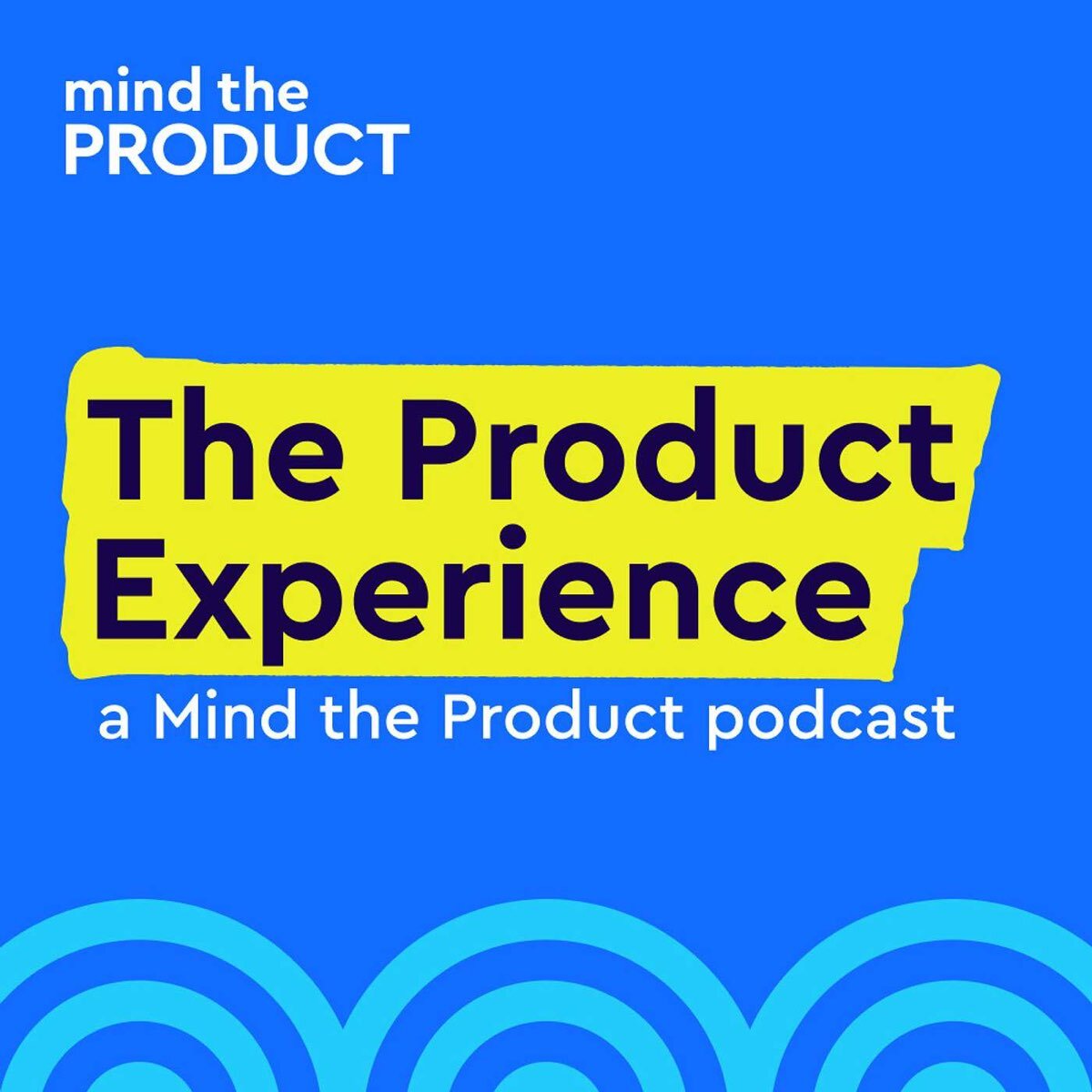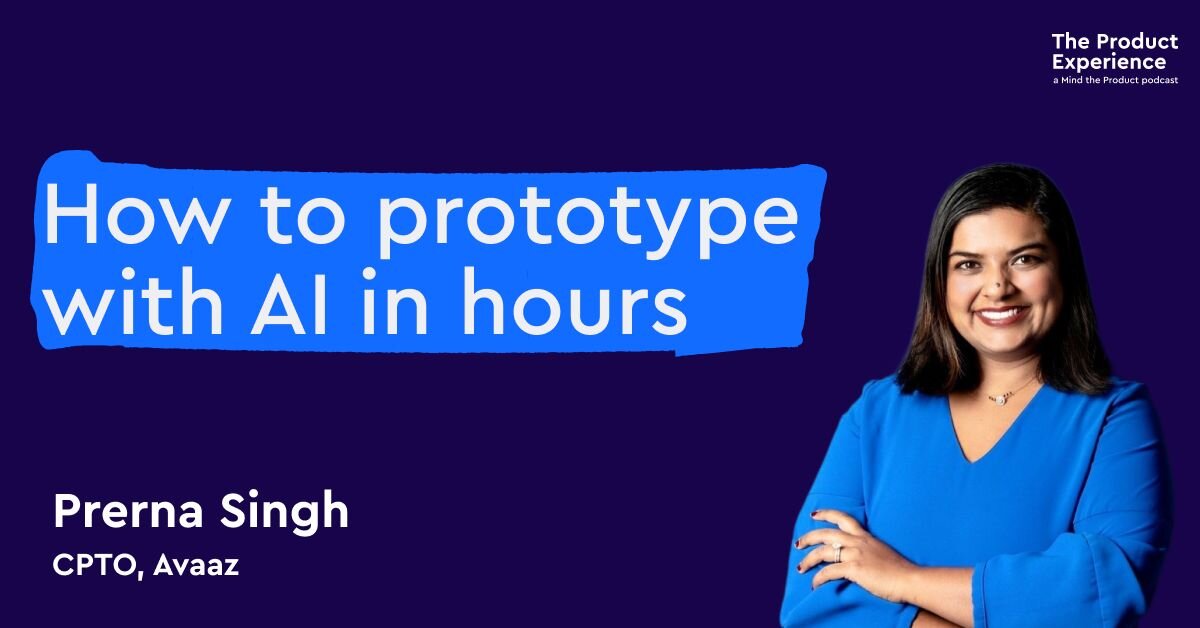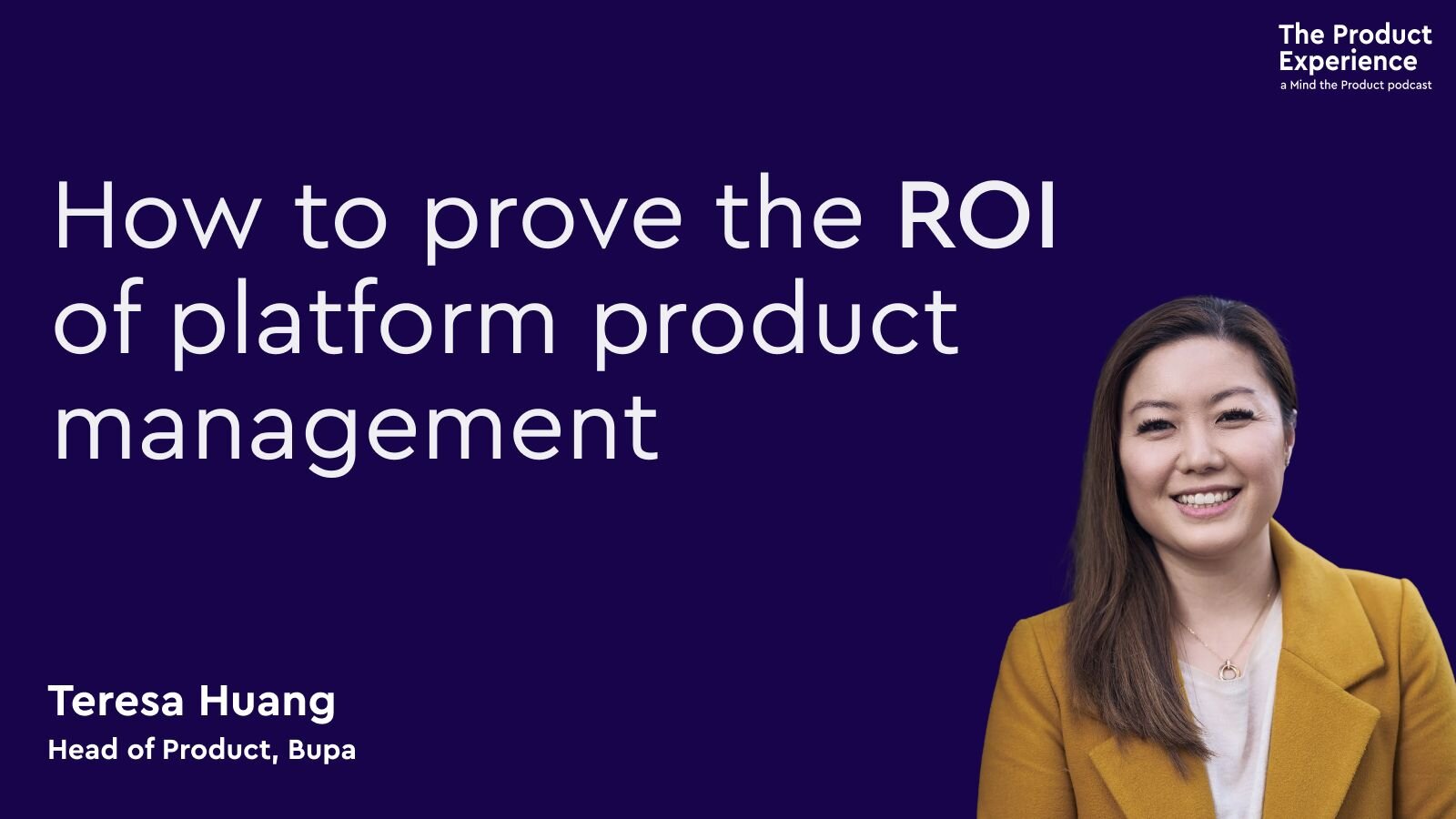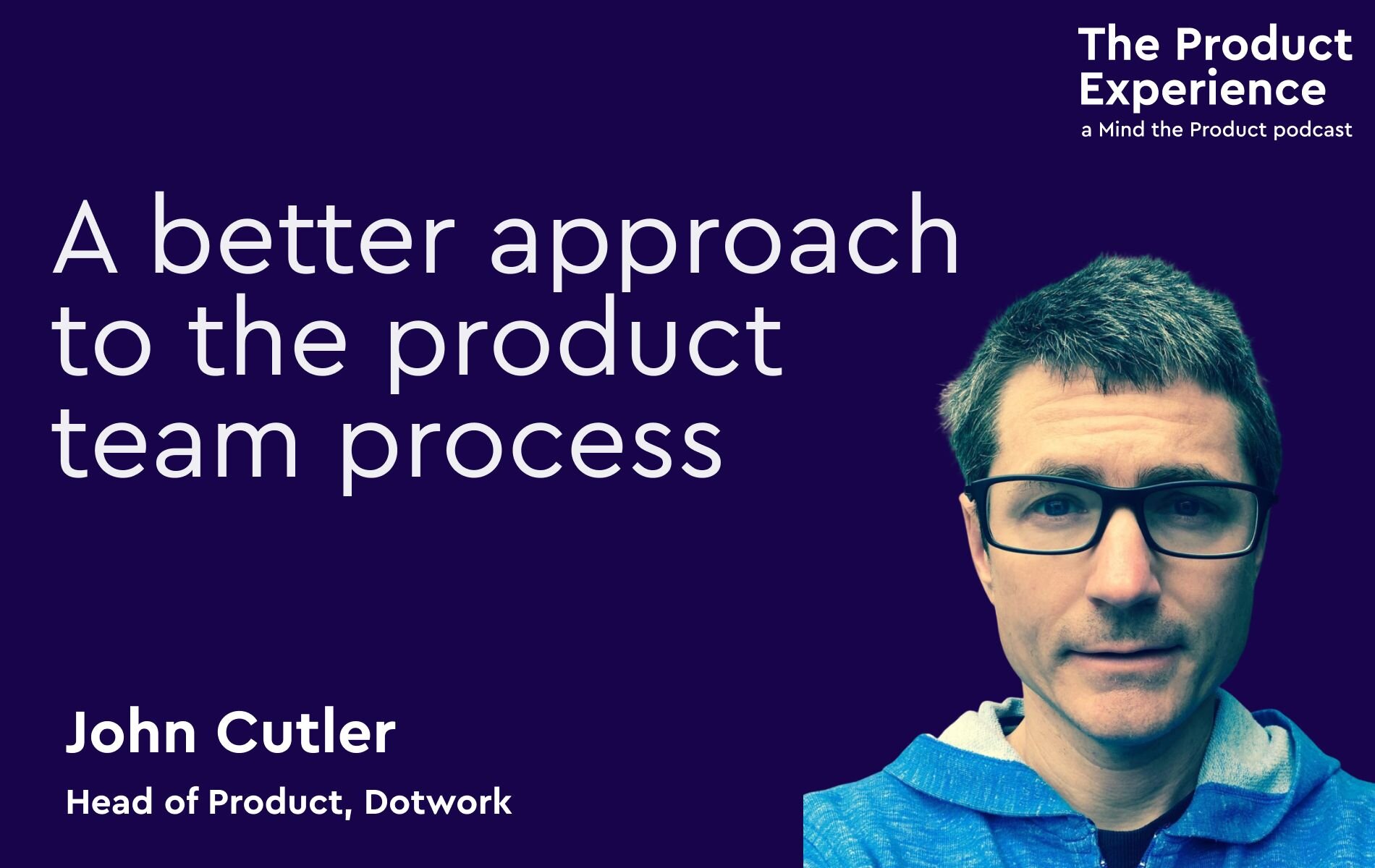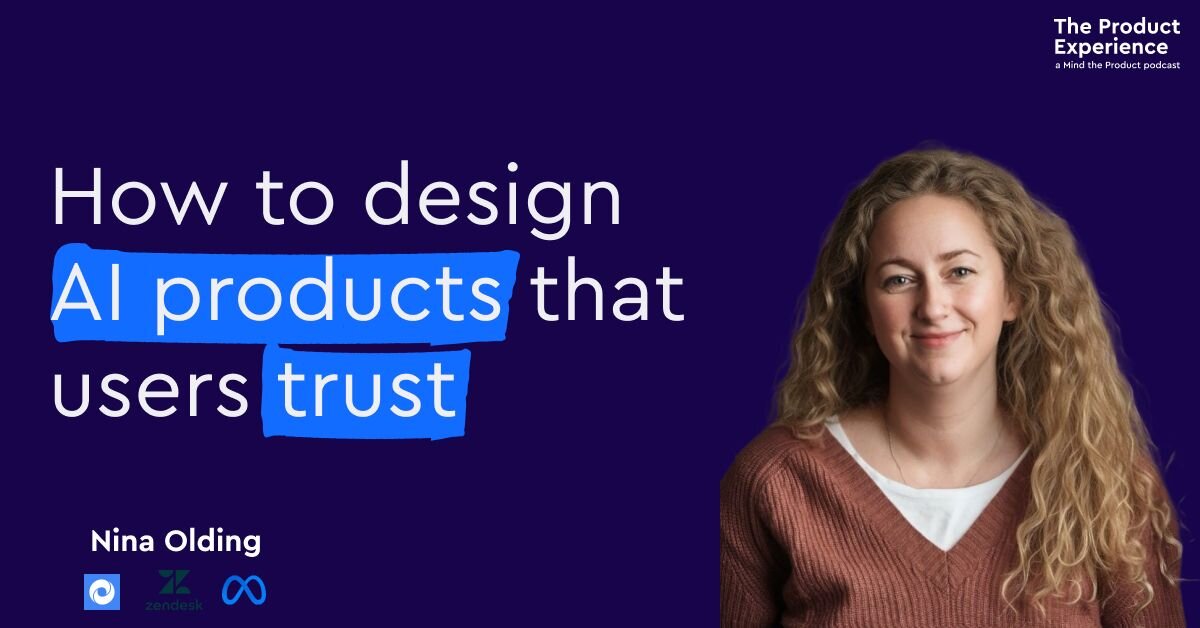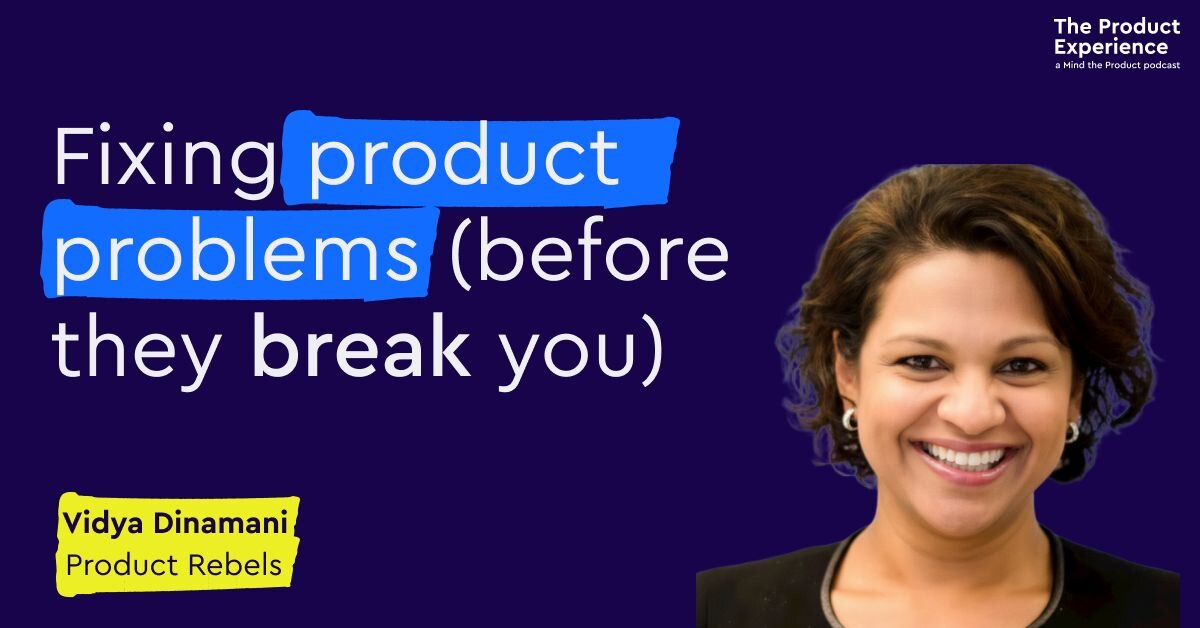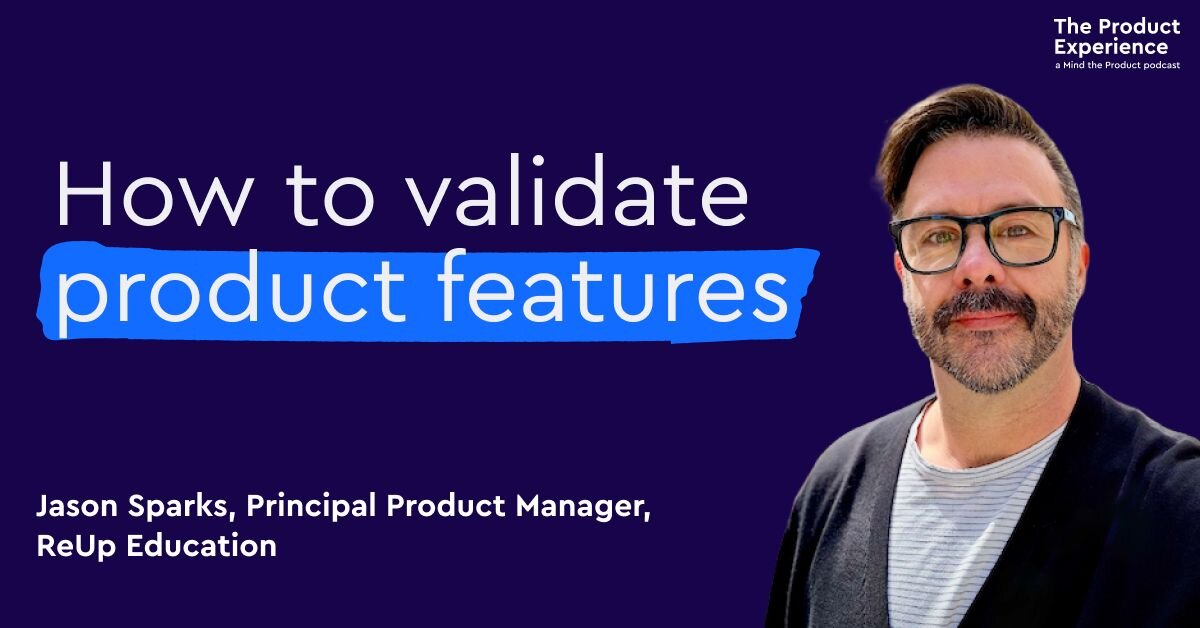Timestamps
Featured Links: Follow Tami on LinkedIn | Product Leader Coach | Tami's book 'What do Product Managers do?' | Watch Tami's talk 'The Only Three Questions You EVER Need'
Episode transcript
Randy Silver: 0:00
Hey, Lily , it's nearly Christmas, which usually means that you know, whatever your beliefs and heritage, that you'll be spending time with family and friends, and that always seems to result in the hardest question any of us have to answer. So, gully, what do you say when someone asks what a product manager actually is? Gully, oh, that's right. Sorry, gully can't make it today. She's got an offsite with her team, which means it's just me. Well, not just me. I'm joined today by Tami Reese. She's a great product coach and instructor who has a great answer to this question, actually. So let's not waste any time, just hit the music and let's get straight into it. The product experience is brought to you by Mind the Product. Every week on the podcast, we talk to the best product people from around the globe.
Lily Smith : 1:02
Visit mindtheproductcom to catch up on past episodes and discover loads of free resources to help you with your product practice. You can also find more information about Mind the Product's conferences and their great training opportunities happening around the world, and online.
Randy Silver: 1:17
Create a free account on the website for a fully personalized experience and to get access to the full library of awesome content and the weekly curated newsletter Mind. The Product also offers free product tank meetups in more than 200 cities. There's probably one near you, Tami. Thank you so much for joining us this week. How are you doing?
Tami Reiss: 1:38
I'm doing great. Thank you so much for having me.
Randy Silver: 1:40
So for anyone who doesn't already know you and shame on them can you give us a quick introduction? What are you doing these days and how did you get into the product racket in the first place?
Tami Reiss: 1:52
Oh, that's a long answer. Hi, I'm Tami Reiss, also known as Tami, from Miami. I am also known as the product leader coach, and what that means is I work with up and coming product executives and product leaders to help them be awesome. I also do a number of other things to help product people at all stages of their careers be awesome, which includes I'm working on a children's book, I do some stuff with product institute, I am working on recording a course with product alliance around mastering roadmaps, and I speak at conferences and companies and a variety of other things all under the auspices of helping people be awesome.
Randy Silver: 2:37
Oh, I like that. So how did you get into product in the first place?
Tami Reiss: 2:41
Oh yeah, that's the longer story.
Randy Silver: 2:43
Let's do the short version of the long version.
Tami Reiss: 2:47
I got into product while I was at farmers insurance doing some what they called product work, but then they switched me to a real product team Because I wasn't as good at math as the actuaries and I had a marketing business brain and yeah. So that's how I got into product and I never looked back but I realized I've always sort of been in product. I was the. My first job was a fundraiser and I was the fundraiser who did analysis of what zip codes were doing best and I AB tested our call scripts and things like that. I just didn't know that was called product management. So, yeah, that's how I got into product and I have spent over 15 years doing product one way or another and I specialize in B2B SaaS products for the enterprise.
Randy Silver: 3:42
I love your take on that because you know I get the question all the time from people of how do I get my first product job, how do I become a product manager? And one of the things I tell them is you don't have to have the title to use the approach and do this stuff. You can do it in almost any role and that's a perfect example of it.
Tami Reiss: 4:00
Yes, 100%. The stump speech I used to give was called everyone should be a scientist, which is pretty much incorporating the product mindset, and nowadays it's called the only three questions you ever need, which is how do you incorporate the product mindset into all decision making?
Randy Silver: 4:18
And that is the talk that I saw you do when we were both at productized in Lisbon a few months ago. So let's go straight into it. Before we dig into each of them, just tell us what are the three questions and then tell me how did you come up with these as your shortcut for it.
Tami Reiss: 4:36
Well, it's not how product people are just resting, it's about everybody should approach things, but how can everybody incorporate the product mindset into decision making? And so there are two big things that were going on that contributed to these questions happening. One is the very common question I had gotten for 15 plus years, which was what do product managers do? And I would start by saying we're the people who decide what to do next. And the way we decide to do that is we communicate out and we do a whole listening thing and we listen and we ask questions and then we evaluate possibilities and we then make decisions and we prioritize what to do next. And, as I mentioned a few minutes ago, I used to also give this speech called everyone should be a scientist, which is about incorporating the lean methodology into anything you're doing. So the lean method version is build, measure, learn, which a lot of people learned about through Eric Ries' book, the Lean Startup no relation to Eric, but in the scientific community which I have my educational background in, we call it observe, hypothesized test, and so I was talking a lot about that and at some point when I was explaining what does it mean to be a product manager to a group of budding associate product managers. I helped them understand that there is where do we want to go, which is your vision and your long term goals and the outcomes you're trying to generate. That's question number one. Question number two is where are we now, which is around product operations and data, and all of that listening tour, user feedback, seeing what's going on in the market, all the things that we do as product people to understand the here and now. What does our solution currently do? And then, where should we go next, which is what product managers are in charge of deciding what to do next. And so that was a good way of explaining the all three parts of product management, which are where do we want to go, where are we now and where should we go next, or where from where to where next the super shorthand on that, and it's been an evolution, but I really do believe that the product mindset can be applied to pretty much anything, and so that's my stump speech for today.
Randy Silver: 7:06
I like it. Let's dig into each of the questions a little bit more than that. So, starting with the first one where do we want to go? How do you know? What are the tools that we use? What are the things that you need to have in place to have? It's not just what I put my finger in the air and say I want to go that way, so what is it that I need to have to coherently be able to say this is where we want to go?
Tami Reiss: 7:31
So it may be a company vision, it may be a mission, so it could be the mission of an organization. And what you're really trying to ask is, if the world were a better place because of the things I'm about to put into the world, what would it look like? That's what a vision really is. The world should be different. What do I think it should look like if it were different and better? And so I just mentioned this could be a company or a nonprofit, but similarly, you could apply these questions to yourself your career, what would your life look like if it was different and better? What would your job look like if it was different and better? What would a relationship look like if it was different or better? Or, on the micro scale, what would a meeting that happens every week look like if it was different and better?
Randy Silver: 8:25
I like that. Okay, so we'll dig into a little bit later on whose responsibility it is to supply these things. No-transcript. I really love the second question. I think this is my favorite one. Where are we coming from? What does this mean? Why is this something that isn't always covered?
Tami Reiss: 8:47
So I think, first of all, most people choose what to do next. First we center on, someone has an idea about something that should happen, and then everyone asks feasibility questions oh, what would it be involved with building that? What will be involved in financing that, what will be involved in making that happen? As opposed to should it happen at all, which is the valueability question, which is, where do we want to go is important Because it helps frame the long-term vision. And is this something that helps us get closer to that? So that's why I say always start with question number one. But question number two helps you understand well, how far are we away from that end desired goal? How far are we away from that post out there, that North Star, that audacious outcome of a better world that we want? Where are we now? That helps us understand not only how far away are we, but what resources do we have available? Who is on our team? What are our special talents, what are our unique selling propositions, what are our capability gaps that are preventing us from being in that future state which is amazing and different and better. And so, for a company, this might be looking at. Well, what does our product line missing. We might need a whole additional product or a new service For a product. It might be we're missing these features or we need to adapt a feature or advance a feature For an individual's career. You might need to get an education in something or training in something or experience in something in order to fill in a capability gap. But before you can choose what to do next which helps you get closer to your desired end state, goal future, you got to know where you're coming from right now.
Randy Silver: 10:44
And.
Tami Reiss: 10:44
I didn't mention this earlier, but hopefully at some point, someone who's listening connected the dots. And these questions are all directional questions and they are exactly what Google Maps asks you. They ask you where do you want to go, they set your current location as the default, where you're coming from, and then they show you where to go next. But you need those first two in order to choose the next.
Randy Silver: 11:13
So the problem with this one? I think I'm going to do horrible stereotypes, but I think it's a useful stereotype in this case. This is the one where sales or the CEO or somebody comes in and says, can't we just? I think a lot of times they're assuming we're right next door to where we want to go. We don't have to. There are no obstacles, in a way, We'll just get there easily. And that word just is always the scariest one in technology as far as I'm concerned.
Tami Reiss: 11:41
Or any question that sales brings to you. Hey, can't we just do this thing? And if you can say that's a really great idea, let's make sure it's in line with our company's vision of what we're supposed to do, the markets we're supposed to serve, the problems we're supposed to solve for them, the world that is better that we're trying to create. Does this help us get there or not? And, based on where we are right now, is this necessarily the best next step, because it may be out of order of other steps which may be higher impact or open more doors or be more efficient in development or anything else that might be a way of helping them realize that we're trying to connect the dots and your dot is a little advanced from where we are today, or it's a little too far off the path and too much of a road trip that isn't helping us get to where we need to go, or it steps backwards, or it might create steps backwards. This is something that, if you think about racking up tech debt, that's like taking steps backwards to a certain degree.
Randy Silver: 13:01
Okay, so the last question where should we go next? I think one of the interesting things about using the Google Maps analogy is it takes your starting point, your current location, it shows you how to get to the destination, but it usually gives you a couple of alternatives, and that's not something that we always do, is it?
Tami Reiss: 13:20
No, it's most certainly not something we always do. Part of being a good product manager is thinking about the different options you have to solve the problem you want and not falling in love with the first solution that gets mentioned and not going along with the highest paid person in the room's opinion, etc. But, to understand, there are many options available to us for how to reach this next flagpole on our way towards our final destination, and so in Google Maps, that's things like public transportation or hailing a cab or walking or biking, and some things are slower, like walking versus driving, but they allow you to get feedback along the way a little better, potentially. And some things involve hiring somebody else, which is really the build by partner question, or the build by ally question, which is do I need to be the person driving this car?
Randy Silver: 14:21
Is this critical? Is this a unique advantage for us? Is this critical? Do we need to build this ourselves or is this just a service we can hire? It's a very wardly map type question as well.
Tami Reiss: 14:33
Yes, exactly. Or, if you think about it, a bus is kind of like. Can we use a publicly available third party system that many people are going to share with us?
Randy Silver: 14:44
Yeah, that makes sense and I think that to really torture the maps metaphor, the nice part about it is also you re-root. Sometimes You're going along a certain way and a better option opens up, or you find out that it isn't quite working the way you expected.
Tami Reiss: 15:01
You can change and still get to the same destination 100%, just like in Google Maps, where all of a sudden there's an accident and it says rerouting to avoid a delay. If you think about it, development is supposed to be a learning experience where, as we start doing discovery, as we start doing development, we're supposed to learn. Every day, we're supposed to learn more and if, along that path, we learn that our original desired route isn't going to get us to our end destination, change your plans.
Randy Silver: 15:35
So I really like using metaphors. I think the storytelling is great in this. Do you find it helpful when explaining to partners, to stakeholders, to people not directly involved in the build process that when things change, this is the phase we're in, we're in the where should we go next phase, and it's like driving to grandma's house, except we found construction on the way, or something like that. Is that how you approach?
Tami Reiss: 16:01
it. So I used to say it shouldn't be called a roadmap, it should be called a flight plan, because everyone's been on a plane where there's turbulence or something that happens, which means you have to go a little higher or a little lower. Luckily, most of us have not been on a plane where someone has an emergency that means you have to land in a city that wasn't your final destination. But the idea of a flight plan is and the same thing happens when Google Maps creates that initial route is based on what we know right now. This is our best plan on how to reach our destination. But the world is going to change every minute as we progress towards our destination and we may need to make adjustments. But if we keep that end destination in mind, we can make better decisions about how to adjust appropriately. But if all we're worried about is what to do next, very often we're like oh wow, there's a big accident. I guess we should turn around and go home. That isn't what you want. You want to have this end goal always in mind so that you can come up with advanced solutions when there are bumps in the road or turbulence.
Randy Silver: 17:16
And I'm sorry, just going back to the communication side of this, do you find that other people understand it better in this context, or is this something that you use only as your own mental model?
Tami Reiss: 17:27
I think it's something that, luckily, most of us have been in a car or an airplane. It's incredibly helpful to help people understand, especially when you're giving a status update. That may not be great. Hey, we learned something. There was traffic along the way and thus we have. It might take a little extra time. Or we're going to do this alternative route. We're not going to take the express lane anymore, we're going to take the regular lane, but we're going to be a week or two delayed, but we're still going to get there. Having that context of we're still going to get to our end destination is very helpful. Or, hey, we learned that end destination is actually not that attractive to customers and instead we're going to go to this other destination, which really is.
Randy Silver: 18:13
We're going to.
Tami Reiss: 18:13
Hawaii instead. Yay, exactly right. Or like it doesn't even have to be Hawaii. It might be like hey, we thought we wanted to go to Disneyland, but we figured out we should go to Disney World for this other reason, right.
Lily Smith : 18:27
Or.
Tami Reiss: 18:27
Legoland or Universal Studios, or we're going to Disneyland Paris because it turns out our European people couldn't get visas to get to the States, or whatever. It is right, but if the idea is we're trying to create an environment of happiness, any of the Disney's work.
Randy Silver: 18:47
Okay. So that's spoken very much as someone who's got young children, so I'm going to torture that metaphor instead. Now, stakeholders, sometimes I say a lot of times that being a parent made me a better manager no-transcript when you've got various people saying I want to go to this place, I want to go to that place, and they're not. You don't have that full alignment at the leadership level or even at middle management level, where they're they're asking for different interpretations of getting to that goal. How do you know what to say yes to?
Tami Reiss: 19:21
so I Always am one of those people who's like a five wise people where I asked like why? Why do you want this? Well, why is that important to you? What's the value going to be? Which, if you think about it, is when do we want to go? So the five wise is an exercise that helps us understand where do we want to go, because I like to get to the heart of the matter. If you're asking me for something, there's probably many layers behind it as to why you think this is valuable. So help me along on that journey with you. Explain it to me Can always be very helpful, because I want to make sure something is actually going to be valuable. And what I found is is that when you can get to the why of something, even when you see that Stakeholders are asking for different things, there's more alignment in the why that end state they're trying to generate. And if you can explain to them here is what we're actually going to choose as what we're going to invest in, but it still helps you get to what you want your goal you have a better help in Having them understand that simply because their solution is not what's being Developed doesn't mean that their problem isn't being solved.
Randy Silver: 20:38
So these questions are all where questions and, to an extent, why questions. None of it is a how question. Is that intentional?
Tami Reiss: 20:49
Um, I don't think it's necessarily intentional, other than I love alliterations, but to me, even if you're a developer and you're going through the how, you should be saying to our self yourself, like where do I want this code to go? Like what's the end state of what I'm trying to build? I used to work for pivotal labs, which is all about Continuous deployment and red green testing and all of that stuff. And so I mean CI, cd, right, continuous integration and so, and test-driven development. And so, if you think about it, test-driven development is saying where do we want to go? We want to get to a place where all of our tests run green. Where are we now? All of them are red, or three of them are red right, and I'm like where should we go next? Well, which one of these things do we want to turn green next? Yes, but I also think that these questions can be really empowering, because to me, as you said, management, leadership, etc. Management and leadership isn't about knowing the answers to all three of these questions. It's about saying, depending on what my role is right now orchestrator or operator.
Lily Smith : 22:02
Mm-hmm.
Tami Reiss: 22:03
I have to answer one, two of these questions, but never all three. And so very often, as a manager or leader, you're giving and your quote-unquote strategy deploying when do we want to go? You're helping the team understand where we are now because you might have to teach them more about the market or the company, etc. And then it's up to the individual teams to come up with options that help us get closer to the where we want to go with what comes next. And so, similarly, a product manager, when you're writing out a user story, that's a where do we want to go? We want to go to a place where this user's need is fulfilled. Where are we now? The acceptance criteria are not yet met, right, mm-hmm. Where should we go next? That's up to the engineers to figure out how to code it to make it work.
Randy Silver: 22:48
So what is the difference between someone wearing the in the leadership role versus in the the Individual contributor role I hate saying individual contributor for product managers? There's none. Of us are do anything by ourselves, but Regardless that's a really good point, randy. But regardless, in between it does things. Someone is in that head VP Director type role and someone's in the individual team role. Which type of questions should they be leading on? Which type of question Should they be answering and which type of questions should they be asking the other people to take lead on?
Tami Reiss: 23:27
So I think that, as a leader, you will more probably be in the where do we want to go? Question more often Mm-hmm, and that could be about a process. That could be about a team structure, organizational design Like what do we want this to look like? What would better be right, what would awesome be? And as an individual contributor or a Person who is more on the ground work working, you're going to be more centered in what to do next as well as understanding where we are now. So, as a product manager, you're going to be looking at customer success tickets. You're going to be looking at win loss ratios and loss reasons for sales. You're going to be looking at idea boxes or user voice or whatever you're using to Incorporate ideas from your existing customers. You're going to be looking at the market, and that's your job, but it tends to be the more senior you are as a product person, you're going to be more involved in those activities versus the individual user story writing when do we go next? And so, over the course of your career, you will advance more and more into answering More where should we go, questions versus where we're next.
Randy Silver: 24:36
I Think we've all been in this, the scenario where, at some point in our career, people above us have not given us the direction for something critical, nor do they necessarily trust us to come up with it on honor on our own. So when you're in that, that, that realm of uncertainty, any advice on how to figure out, how to get from here to there in terms of resolving uncertainty with leadership?
Tami Reiss: 25:02
So I think what you're leaning on is how often a company, a product, does not have a vision, does not have a future state that they're aiming towards, does not have a strong North Star metric that they're monitoring, or North Star as to what they're going for, or a mission or whatever you want to call it Some sort of out there. this is where we're headed and it's incredibly common that it is missing and it is a really unfortunate situation, and what I suggest to everybody who asks this question because it is probably the most common question I get asked when we go through these three questions or any of the strategy teachings I've ever done is why don't you take a shot at it? Take a shot at it, try your best and say this is what I think it should be and present it to your leadership, whether that's your immediate boss or a skip level, and say, in the absence of hearing this, this is what I came up with. What adjustments do you, with your more context, think are necessary to make this a strong vision statement, mission statement, north Star, etc.
Randy Silver: 26:11
I love that. I used a very similar technique. I do some work with one of the UK government departments and they were having a lot of trouble getting an answer from one of the ministers they work with. And that's to be expected. These people are politicians that actually nailing them down on something can be quite slippery. That's one of their strengths. So, instead of Amazon's, write the press release. I said write the minister's speech. We're going to spend an hour and we're going to get together and we'll write the speech of what they'll say in the House of Commons or in the press conference, and it doesn't matter if it's right or wrong. It's something to take to them and say is this what you want to say? And if they say yes, then fantastic. But if they say no, at least you've crossed some things out and hopefully they'll correct you.
Tami Reiss: 26:58
Yeah, and hopefully you'll get more clarity, Because simply putting something down on paper that someone can disagree with or agree with will give you more information than asking a too expansive a question. And I've actually given this advice to people who have direct managers that aren't very good at giving feedback, Because if you ask someone who isn't very good at thinking expansively hey, what did you think of my speech today? Or what did you think of this presentation or this document I produced More often than not they'll say something like oh, it was fine, it was okay. Yeah, and that's horrible feedback because you don't know how to make it better. But if you can ask them a more precise question like was this the right length?
Lily Smith : 27:45
Mm-hmm.
Tami Reiss: 27:46
Right, or what adjustments would you suggest for the presentation for this new audience I'm giving it to? Then you're asking a much more concrete and direct question and you have a better chance of getting feedback that will guide you towards a better state for yourself.
Randy Silver: 28:03
I love this. All of these things are tools to have better conversations with people, and that's exactly what you're getting at.
Tami Reiss: 28:09
Yes, alignment.
Randy Silver: 28:12
Clarity, alignment, understanding, yeah, fantastic.
Tami Reiss: 28:16
Yeah, all of the things. It's actually amazing to me how much communication is the most key thing to being successful in the variety of realms.
Randy Silver: 28:29
Tami. Thank you, this has been fantastic. I think we've got time for one more big question. This one came up in your talk and it's not about me and you, but where should we go next on vacation? How does this relate to these three questions that you came up with?
Tami Reiss: 28:47
So I say that these are the only three questions you ever need, and they're applicable to business, leadership and life. And why not turn them into the questions you need for choosing where should we go on vacation? And too often people hear about a friend going somewhere and they say, oh, that was great, can we go there too? And it becomes a feasibility question when can I take off time? Where? What hotel should we stay at, as opposed to, is this even where you want to go? So if you start with that, where do we want to go? What are the goals of our taking a vacation? Are we trying to get away as a couple? Am I trying to get away from my spouse and hang out with a friend? Am I trying to enlighten my children and expose them to new cultures? Am I trying to go on some sort of mission trip where I'm giving back right, like, what are the goals that will help me feel fulfilled while I'm not at work? And that's the. Where do we want to go? And then the where are we now? Is the reflective questions over what are my, what are my budget? What is my tolerance for safety? How long of a flight am I willing to take Right? Do I hate stopovers or not, right? And when was the last time we saw grandma? Is she sick, right? All of these are the questions we need to ask for the. Where are we now? Before we choose, where should we go on vacation?
Randy Silver: 30:10
I love that we've got a good friend who got the mindset of a backpacker. She will do anything to save $5. She, you know she will sleep in an airport overnight and all that. She'll subject her kids to all that and we don't want to do that with our kid. We would never do the same, the same approach. We may get to the same destination, but we would do it in a totally different way and we would allocate a different budget to doing it than she would, or we won't go, and it's just a different mindset. And it's a great question to ask.
Tami Reiss: 30:39
But it's so. Vacation is such a personal thing. Like my husband, cannot spend more than an hour on the beach, which means so many Caribbean beach vacations and cruises and going to the Seychelles or Mallorca.
Randy Silver: 30:57
You live in the wrong place.
Tami Reiss: 31:00
Yeah, I mean we live in Miami but we don't go to the beach that often because he's just not a beachgoer and therefore a lot of people's idea of vacation, which is palm trees and sand, is not his idea of vacation. He would much prefer to spend two days in Amsterdam exploring culture and going to museums. That's his idea of vacation.
Randy Silver: 31:21
And understanding that, for what your stakeholders, what your partners want, is absolutely critical to making sure that they have a good vacation or a good experience in you delivering the product.
Tami Reiss: 31:31
Exactly 100%, and therefore you could really use these questions anywhere.
Randy Silver: 31:36
This is brilliant. I absolutely love the metaphors, I love the storytelling. This is really relatable, it's really useful and it's been fantastic. Thank you so much, Tami.
Tami Reiss: 31:45
Thank you for having me, randy, it's been great.
Lily Smith : 31:56
The product experience is the first and the best podcast from mine the product. Our hosts are me, lily Smith and me, Randy Silver. Lu Run Pratt is our producer and Luke Smith is our editor.
Randy Silver: 32:12
Our theme music is from Hamburg based band POW. That's PAU. Thanks to Arnie Kittler, who curates both product tank and MTP engage in Hamburg and who also plays bass in the band, for letting us use their music. You can connect with your local product community via product tank regular free meetups in over 200 cities worldwide.
Lily Smith : 32:33
If there's not one near you, maybe you should think about starting one. To find out more, go to minetheproductcom. Forward slash product tank.
